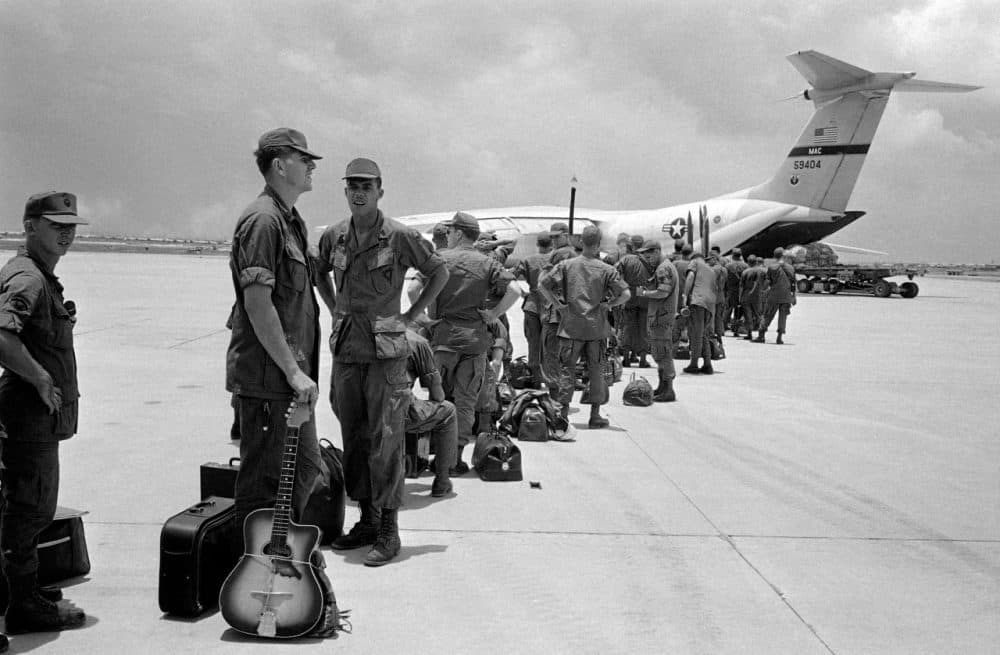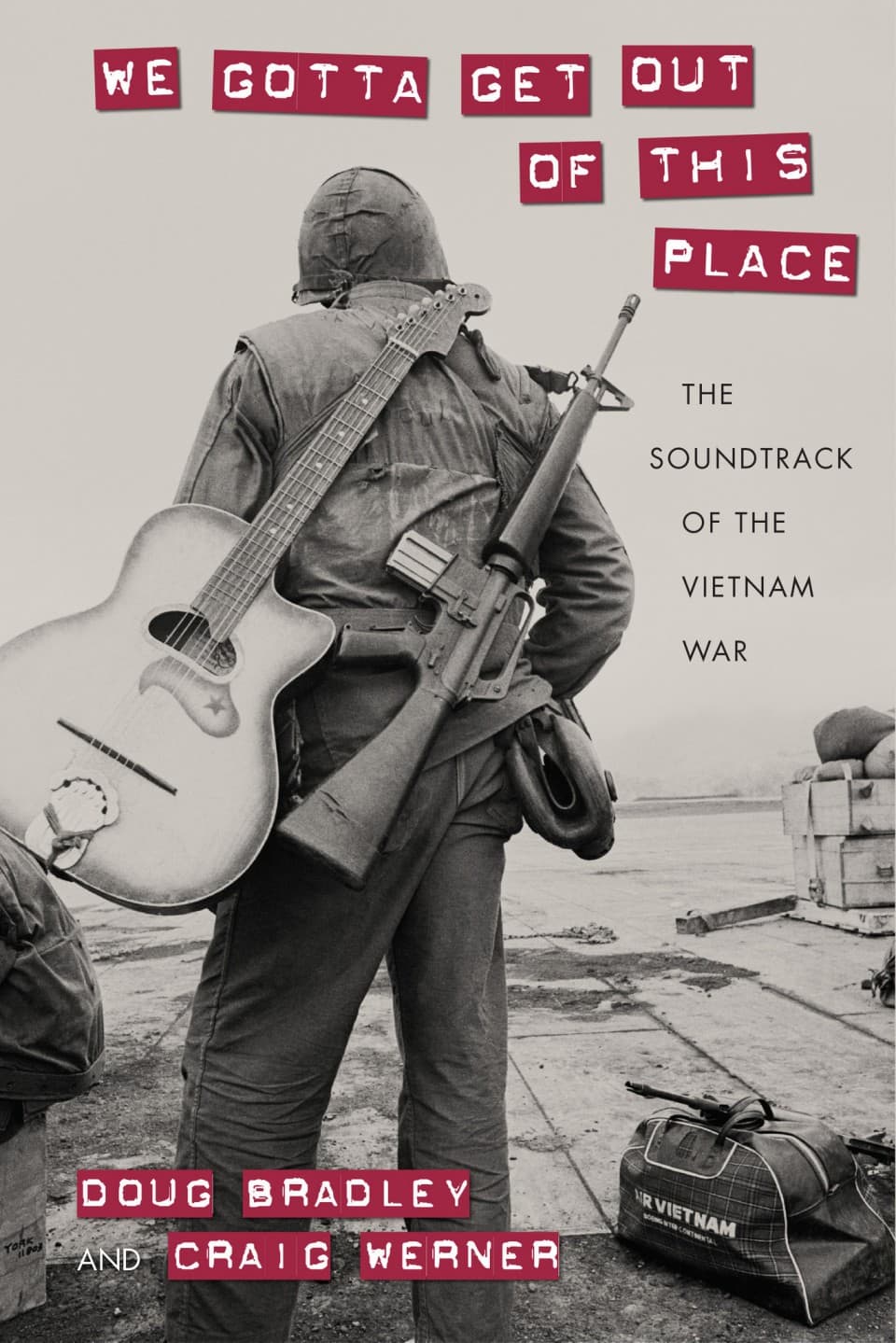Advertisement
The Vietnam War Divided The Country, But Music United The Troops

A new book explores the way Americans who served in the Vietnam War turned to music to cope. They listened to the radio, or on cassette desks or reel-to-reel tape players. They loved Hendrix and Nancy Sinatra, and especially songs that had anything to do with going home, because that was their main goal. And so many didn't make it.
Here & Now's Eric Westervelt speaks with the co-authors of "We Gotta Get Out of This Place: The Soundtrack of the Vietnam War," Douglas Bradley and Craig Werner. Bradley is a veteran of the Vietnam War and Werner is a professor of music and literature in the Department of Afro-American Studies at the University of Wisconsin, where together they teach a course on the war.
Book Excerpt: 'We Gotta Get Out Of This Place'
By Doug Bradley and Craig Werner
Introduction: The Vietnam Veterans’ National Anthem
In early February 1968 the CBS Evening News broadcast a segment from Khe Sanh, the outpost in northwest Quang Tri province where a U.S. Marines base was under siege by the North Vietnamese Army (NVA). Vastly outnumbered and unsure of when or if a full-scale attack would begin, marines played cards, smoked, hunkered down at the sound of incoming artillery, and scrambled to pick up desperately needed supplies dropped by parachute.
A young man from Bravo Company of the 3rd Recon Battalion, dirt, grime, and sweat caking his face, answered the CBS reporter John Laurence’s question, “How do you keep your spirits going?” by saying, “I guess we play cards and sing at night.” Throughout the segment a group of a half dozen marines sat on a bunker strumming guitars and singing “Where Have All the Flowers Gone?,” a song written by the World War II veteran and pacifist Pete Seeger. “Where have all the soldiers gone, long time passing?” The segment faded out as they sang the lines “Where have all the soldiers gone?/Gone to graveyards every one. When will they ever learn?/When will they ever learn?” Watching the clip almost half a century later, you can damn near hear the words echo in the thick I Corps air.
For the marines at Khe Sanh and the more than three million other men and women who served in Vietnam, music provided release from the uncertainty, isolation, and sometimes stark terror that reached from the front lines to the relatively secure rear areas known as the air-conditioned jungle. But the sounds offered more than simple escape. Music was a lifeline connecting soldiers to their homes, families, and parts of themselves they felt slipping away. It was the glue that bound the communities they formed in their hooches, base camps, and lonely outposts from the Mekong Delta to the ravines of the demilitarized zone (DMZ). Both in-country and “back in the world,” as the troops called the United States, music helped them make sense of situations in which, as Bob Dylan put it in a song that meant something far more poignant and haunting in Vietnam than it did back in the world, they felt like they were on their own with no direction home. For the fortunate ones who did get back home, music echoed through the secret places where they stored memories and stories they didn’t share with their wives, husbands, or children for decades. Music was the key to survival and a path to healing, the center of a human story that’s too often been lost in the haze of politics and myth that surrounds Vietnam.
Advertisement
With the crucial exception of combat situations, music was just about everywhere in Vietnam, reaching soldiers via albums, cassettes, and tapes of radio shows sent from home; on the Armed Forces Vietnam Network (AFVN); and on the legendary underground broadcasts of Radio First Termer. They played it in their hooches on top-of-the-line tape decks they purchased cheap at the PX and over headphones in helicopters and planes. Sometimes the music was live: soldiers strumming out Bob Dylan and Curtis Mayfield songs at base camps; Filipino bands pounding out “Proud Mary” and “Soul Man” at EMCs and Saigon bars; touring acts from Bob Hope and Ann-Margret to Nancy Sinatra and James Brown granting momentary calm in the midst of the military storm. AFVN blanketed Vietnam with songs from stateside Top 40 stations. Soldiers in remote areas maneuvered their transistor radios in hopes of catching the week’s countdown of stateside Top 40 hits, while radio helped helicopter crews fill the empty hours crisscrossing the airways above the endless forests and rice paddies.
The songs the troops listened to were the same ones their friends were listening to back home, but the music took on different and often deeper meanings in Vietnam. Nancy Sinatra’s “These Boots Are Made for Walkin’” became a minor anthem to the soldiers humping endless miles on patrol; no one listening to the Jimi Hendrix Experience’s “Purple Haze” in a college dorm room was likely to associate the title with the color of the smoke grenades used to guide helicopters into landing zones. “Ring of Fire,” “Nowhere to Run,” “Riders on the Storm”: all of them shifted shape in relation to the war.
The songs and stories that form the chorus at the center of We Gotta Get Out of This Place: The Soundtrack of the Vietnam War are intensely individual; there’s no such thing as a typical Vietnam vet. But collectively the songs come together in a shared story of what music meant, and means, to the young men and women who shouldered their country’s burden during a period of dizzying change. Most of them belonged to a generation that, probably more than any other, was defined by its music: Elvis, the Beatles, and Dylan; Aretha, James Brown, and the Supremes; Jimi Hendrix, Creedence, and Johnny Cash.
Like other members of their generation, those who served in Vietnam shaped the music they loved to fit their own needs, a process that continued after they returned to the United States. As Michael Kramer observes in The Republic of Rock, the music of the 1960s and early 1970s gave the younger generation “a sonic framework for thinking, feeling, discussing, and dancing out the vexing problems of democratic togetherness and individual liberation.”1 Music in Vietnam didn’t deliver a preordained set of meanings to the troops. Rather, the songs afforded a set of overlapping fields for making, sharing, and at times rejecting meaning. Songs and styles signified something particular to one group and something very different to another; the tensions are especially clear in relation to country music and soul, but they show up again and again. Witness the radically divergent responses to “The Ballad of the Green Berets” and “For What It’s Worth.” Acceptance or rejection of these songs and others was largely shaped by the three Ws—When you were there; Where you were; and What you did. As you’ll read in these pages, the meaning of songs often changed for individual vets whose personal (and in several cases, political) perspectives underwent seismic shifts in the years after the war.
The dynamic was complicated by music’s peculiar status as both a center of political or cultural resistance and a manifestation of American technological power. Building on Thomas Frank’s history of the rise of “hip capitalism” in the 1960s, Kramer argues that especially in the later years of the war music in Vietnam was part of a “hip militarism” designed to reduce the disruptive potential of generational conflict. Soldiers who identified deeply with the iconoclastic messages of the Jefferson Airplane or James Brown simultaneously accepted their place in the highly technological commercial culture that defined American society. Rather than resolving the tensions, however, the material surroundings—painstakingly detailed in Meredith Lair’s Armed with Abundance: Consumerism and Soldiering in the Vietnam War—often intensified the sense of what Kramer calls “the blurred lines between official and unofficial knowledge.”2 Music never arrived in an unmediated form; even the most emotionally direct or politically provocative songs were part of an industry delivered through technological channels that shaped responses, if only subconsciously. As Lair points out, “The widespread availability of popular music, by way of soldiers’ personal stereos but, more consistently, through radio, made a year in Vietnam less isolating and more manageable.”3
The soundscape of Vietnam unfolded in distinct movements, musical and military. As the war changed, the music changed with it. Or maybe the other way around. Without question, however, individual understandings of the music changed over the course of time. A song like the Monkees’ “Last Train to Clarksville,” with its refrain, “I don’t know if I’m ever comin’ home,” meant one thing to a recruit saying goodbye to his family or sweetheart but frequently took on new, sometimes painfully ironic meanings to a soldier or marine who had spent twelve, thirteen, eighteen months in the field. Likewise, the sound of a voice or guitar that once evoked a connection with comrades in Vietnam could ignite intense feelings of sorrow back home. As many of the veterans we talked with testified, music has the distinctive power to unlock deeply buried memories.
Excerpted from the book WE GOTTA GET OUT OF THIS PLACE by Doug Bradley and Craig Werner. Copyright © 2015 by Doug Bradley and Craig Werner. Reprinted with permission of University of Massachusetts Press.
Songs In This Segment
- "For What It's Worth" performed by Buffalo Springfield
- "The Letter" performed by the Box Tops
- "These Boots Are Made For Walking" performed by Nancy Sinatra
- "Say It Loud I'm Black And I'm Proud" performed by James Brown
- "We Gotta Get Out Of This Place" performed by Eric Burdon and the Animals
- "My Girl" performed by the Temptations
- "Leaving On A Jet Plane" performed by Peter Paul and Mary
- "Machine Gun" performed by Jimi Hendrix
- "Chain Of Fools" performed by Aretha Franklin
- "I Feel Like I'm Fixin To Die Rag" performed by Country Joe And The Fish
- "What's Going On" performed by Marvin Gay
Guests
- Douglas Bradley, co-author of "We Gotta Get Out Of This Place" and veteran of the Vietnam War. He tweets @DBradMSN.
- Craig Werner, co-author of "We Gotta Get Out Of This Place" and a professor of music, literature and cultural history in the Department of Afro-American Studies at the University of Wisconsin.
This segment aired on December 7, 2015.